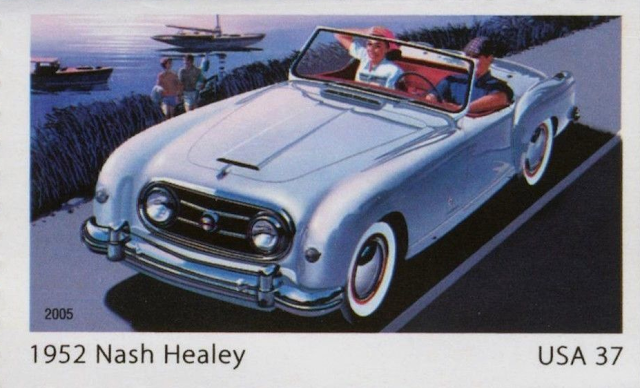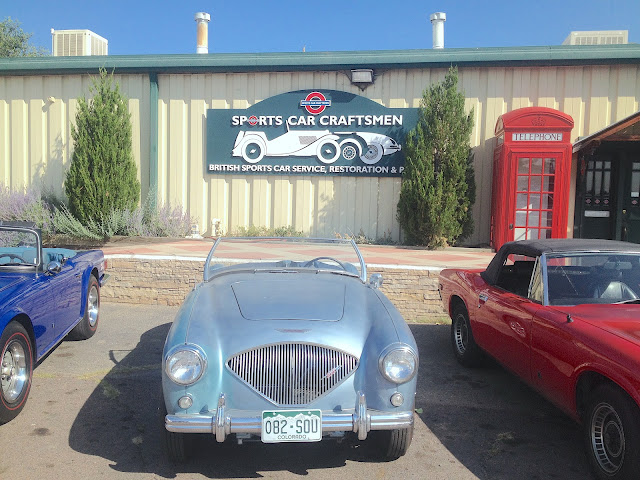Your lazy correspondent arrived a half hour late on the last Sunday morning in October as he was less ready to start at 8 than was his trusty English car. An even later arrival, however, made him forget all about getting in the long line for coffee at Spruce Confections. It's a 1931 Bugatti Type 40A, and in the photo above, its owner invites a car-bewitched youngster to have a look inside. From a perch on the driver's seat, that lucky kid will see this: the manual controls of a hand-built, Machine Age work of art with no microchips, or even plastic, anywhere...
The Type 40A replaced the Type 40 in May 1931 after 5 years and 790 examples of Ettore Bugatti's "entry level" car. Only 40 of the Type 40A were released by the Bugatti workshops in Molsheim, Alsace Lorraine. Nobody used the phrase "entry level" back then, however, and not many would've thought to base a touring car around a racing engine. In the Type 40, this was the Type 37 GP 1.5 liter aluminum overhead cam four cylinder with 3 valves per cylinder (2 intake, 1 exhaust); the Type 40A got a longer stroke for 1.6 liters, and received twin spark plugs per cylinder.
The T40A engine, like all classic Bugattis, resembles a piece of Cubist sculpture, enhanced by the swirls of the "engine-turned" finish on the aluminum firewall. Though Bugatti was an early adopter of advances like multi-valve aluminum engines, overhead cams, and supercharging, the company stayed with rigid suspensions front and rear, and mechanical, cable-operated brakes.
Parked next to the Bugatti we found this Allard* J2X. Offered by Sydney Allard's British firm from 1952-54, the J2X was aimed at American amateur racers during the postwar boom in road races promoted by the SCCA...
For this reason, the J2X was often equipped with Cadillac's 331 cubic inch V8, but some, like this example, featured Chrysler's then-new V8, which had the same displacement, but with hemispherical combustion chambers. The J2X engine was moved back 7 inches in the chassis to improve handling over the previous J2 model built in '50 and '51. Those were powered by Caddy V8s, flathead Ford V8s, and a few Lincoln V12s. Only 83 of the J2X were built, following 90 J2s. Handling, even on the improved J2X, could be dramatic, as both cars featured a swing axle front suspension...
In the same lineup as the Bugatti and the Allard we found a Ferrari F40, a Jaguar XK120 rom the same era as the Allard, and a silver 1968 Dino 246 that is a frequent visitor to the Sunday sessions. By this time people were cheerfully ignoring the No Parking Any Time signs...
Other Bugatti neighbors included the black Ferrari 328GTS in the foreground and a wild, racing red cousin based on Ferrari's V8 engine design...
That would be the F40, introduced to celebrate Ferrari's 40th anniversary as a car maker in 1987. The mid-mounted, 2.9 liter, 4-cam, twin-turbocharged V8 sends over 470 hp to the rear wheels through a 5-speed transaxle. 400 units were planned, but over 1,300 were eventually built by the time production stopped in 1992. Styling was by Pininfarina, as on Ferrari's previous supercar, the 288 GTO.
The yellow Alfa Romeo Type 916 Spider below may have been less familiar to visitors than the F40, because along with its 916 GTV 2+2 sister car, it was never exported to the USA. It was popular in Europe though; the front-driver won design and car of the year awards after introduction in 1995. Over 80,700 of the 916 (Spider and GTV included) were built before production ended for the coupe in 2005 and the Spider in 2006. Styling, by Pininfarina, combined wedge themes with rounded contours...
This Spider, a 1998 model built for export to Canada, has Alfa's 2 liter, 16-valve Twin Spark inline 4. Other engines offered over the production run included 12- and 24-valve versions of Alfa's 60 degree 3 liter V6, and also the 3.2 liter version. Transmission choices were limited to 5- and 6-speed manuals.
As the morning warmed up, the owner of the 1959 Ford Skyliner retractable hardtop gave a demonstration of the hinged steel top's operation. The Skyliner retractable appeared after much anticipation in 1957 and sold over 20,000 copies that year, nearly as many as 2-passenger T-Bird which was in its last year. 1959 was the final year for the retractable, with a bit over 12,900 examples finding homes. A similar rear-hinged deck design, with lots of motors and relays, would appear on the soft-top Lincoln Continental 4-door convertible for 1961...
This little 1972 Steyr-Puch* Haflinger was one of over 16,000 made by the Austrian Steyr-Puch combine from 1959 to 1975. The tiny (59" wheelbase!) 4-wheel driver was intended for the Austrian military, and used the same 643 cc (39,2 cu. in.), rear-mounted air-cooled boxer twin that appeared in Steyr-Puch's comparatively hot-rod version of the Fiat 500 body, and also in a rare, alloy-bodied 2-seater GT coupe. The Haflinger was also adopted by the Swiss Army, sort of like that famous knife. Horsepower was less than in the Steyr-Puch Imp 700 GT* engine, though, at around 30 max. And according to the owner, the military did not enjoy the tendency of the carb to vapor-lock.
Weather protection seems about the same as you'd get with a mobile jungle gym. We especially enjoyed the strap detail that substitutes for the doors, which according to the owner, are fabric over a steel frame. He's fitted a rear vision camera because with the top installed, rearward vision vanishes. Rear seats fold forward, but there are no seatbelts because of the hinge design...
The Lotus 7 offered similarly casual weather protection, with not much in the way of doors, but with a sturdier-looking roll bar. Early Sevens (1958-60) used Ford side-valve fours, but the Super Seven (1961-73) adopted Ford's overhead valve Kent four in 1.3, 1.5 liter sizes, with the Lotus twin-cam available in Series 3 . Power output ranged up to 125 or so, which doesn't sound like much, but in a 1,600 lb. car gives a power-to-weight ratio better than the V8-powered Allard J2X, with better handling too. After 1973 Caterham Cars built the original S3 design (not the wider, heavier S4) under license from Lotus, and maintained the Lotus tradition of offering the car in kit form...
The Jensen Interceptor appeared in 1966 with one of the last styling jobs by Italy's Touring Superleggera. The first 3 test cars were bodied by Vignale; Jensen built the rest of the steel bodies in fastback coupe and (after '73) convertible form, with a few late notchbacks, over 6,400 cars in a decade. Wheelbase was just over 105", power came from a Chrysler 383 V8 (with over 230 cars optioned with the 440 starting in '71), disc brakes were standard, and the only element that suggested cost savings was the live rear axle. The rarer FF model (320 built) as offered from '66 through '71, and offered Ferguson Formula all-wheel drive along with Dunlop Maxaret anti-lock brakes, a first in a production car. One Hemi-powered prototype was built. How can you tell an Interceptor from an FF? Well, there are two diagonal vents behind each front wheel on the FF and a longer wheelbase (109"), and all FFs are right-hand drive.
There were some working class cars to go with all the upper crust stuff on Sunday morning, including this tasty oval-window VW. The small backlight disappeared for 1958...
The lineup of old cars covered both sides of 8th Street and stretched around the corner on this crisp autumn morning, and our extremely casual popularity count tallied the most numerous makes as follows: Porsche in first place by a pile, then Triumph, with Austin Healey and Alfa Romeo tied for 3rd. We wish everyone involved an enjoyable and not-too-expensive winter of tuning and tinkering...
*Footnote:
The following cars mentioned in this piece were featured in previous blog posts; dates are in parentheses:
Allard: "Forgotten Classics: Allard JR and Palm Beach" (January 28, 2021).
Steyr-Puch: "Streamliners from Mitteleuropa: Steyr and Steyr-Puch" (February 16 2019).
Steyr-Puch Imp 700GT: "The Etceterini Files Part 28: Intermeccanica, Sometimes Forgotten, Still in Business" (January 12, 2022).
Photo Credits: All photos are by the author.






































































